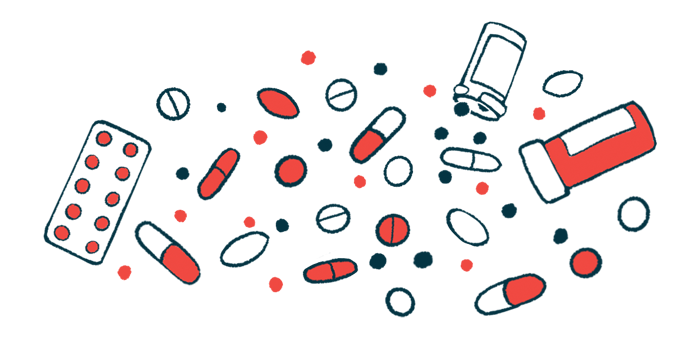Faster steroid tapering, possible with newer therapies, better in long term
Faster remission, fewer relapses seen with lowering steroid doses in Japan study

Tapering immunosuppressive corticosteroids as much as possible during the first year of treatment for ANCA-associated vasculitis (AAV) reduced long-term complications associated with the disorder, an analysis in Japan finds.
Recent developments in AAV treatments have led to faster disease remission and fewer relapses in Asian patients, allowing for faster tapering of corticosteroids and fewer steroid-related side effects, its researchers report.
The study, “Recent advances in the treatment strategy for AAV improved outcomes with intensive GC tapering,” was published in the International Journal of Rheumatic Diseases.
Steroid tapering could risk relapse of ANCA-associated vasculitis symptoms
AAV is due to self-reactive antibodies, called ANCAs, that abnormally activate immune neutrophil cells, leading to inflammatory damage to small blood vessels, primarily affecting the kidneys, lungs, and skin.
Historically, treatment of the immune-based disorder relied mainly on suppressing inflammation through the use of corticosteroids. Because their long-term can lead to serious side effects, it is common to taper, or reduce, their dose over time. However, tapering immunosuppressive drugs raises the risk of disease symptoms returning (a relapse).
More recently, medications such as rituximab, marketed as Rituxan in the U.S. and as MabThera in Europe, with biosimilars available, have been effective in inducing and maintaining disease remission. Other newer medications used with corticosteroids, like Nucala (mepolizumab) and Tavneos (avacopan), also have benefited AAV patients.
The success of these newer treatment regimens has allowed more intensive corticosteroid tapering strategies, reducing doses more rapidly to prevent toxicity.
Researchers in Japan examined whether intensive corticosteroid tapering has been effective for AAV patients in that country.
Using data collected between 2011 and 2021, the team assessed the treatment and outcomes of 43 patients with granulomatosis with polyangiitis (GPA) and 91 with microscopic polyangiitis (MPA), the two most common types of AAV.
As treatment strategies have changed over time, they divided patients into two groups of 67 each — early and late treatment — based on a median patient record registration date of September 2015.
Treatments and outcomes between the early and late groups were compared during three periods: the remission induction phase (the first six months), the initial maintenance phase (seven to 12 months), and the late maintenance phase (12 to 24 months).
Newer therapies like rituximab allowing for quicker steroid tapering
Across all three periods, the late group was treated with rituximab more often, with significantly lower doses of the corticosteroid prednisolone, than the early group. After 24 months (two years), corticosteroid tapering to 5 mg/day or less was attained by 78.8% of the late group, and 23.3% of these patients achieved complete corticosteroid withdrawal.
The late group also reached remission faster, based on Birmingham Vasculitis Activity Score (BVAS), a measure of AAV severity, with significantly fewer relapses. Still, these patients experienced more severe adverse events during the first induction period, but fewer severe adverse events and infections during the late maintenance phase.
To compare outcomes, damage accumulation was assessed using the vasculitis damage index (VDI). This index reflected age, sex, AAV type, ANCAs, lung and kidney involvement, and BVAS, with higher values indicating more severe AAV-related complications.
The VDI at each time point was lower in the late group, and the differences widened over time compared with the early group. VDI-corticosteroid, defined as the sum of VDI items related to corticosteroid side effects, also was lower in the late group. The team noted that VDI progression during both later periods (six to 24 months) was primarily due to corticosteroid toxicity.
After 24 months, the early group had more corticosteroid-related side effects than the late group, including cataracts (clouding of the eye lens; 10% vs. 4%) and diabetes (20% vs. 14.3%). Although there were no overall significant differences in survival, the early group had a gradual increase in the number of deaths.
Analyses “demonstrated that the intensive [corticosteroid] tapering with precise combination of immunosuppressive drugs such as [rituximab] was effective and safe for AAV patients, causing fewer relapses,” the researchers wrote.
In a final analysis, the team focused on dosing factors that predicted VDI values after 24 months, in which the highest values were tied to a significantly shorter life expectancy. Among the factors assessed, the prednisolone dose at 12 months was the only treatment-related factor and one of the strongest predictors of VDI. That is, corticosteroid tapering as much as possible during the first year of treatment was essential to lowering a patient’s long-term complications.
“Recent developments in AAV treatment have allowed efficient remission and prevention of relapse in Asian patients with AAV,” the researchers concluded. “This has also enabled more intensive [corticosteroid] tapering, resulting in fewer sequelae [AAV-related complications].”







